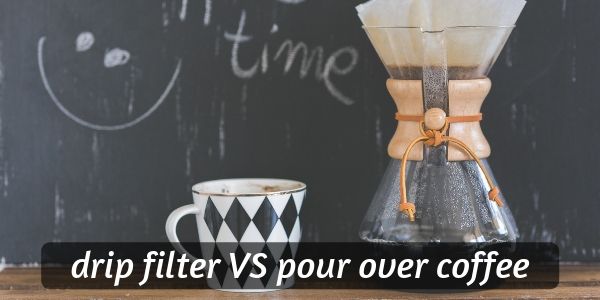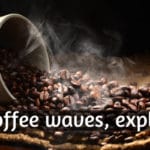You might've heard of pour over coffee and drip coffee, and wondered what the difference is between them.
I know I have, and for a long time I couldn't understand why people keep insisting pour over is better.
So here we are, ready to compare drip filter coffee with pour over, and you can judge by yourself which would be best for you.
Table of Contents
1. Drip coffee is automated and convenient, pour over is manual
One of the things I love about drip filter coffee is that it's automated.
Now, some might hate it for exactly this reason. Machine, programmed, impersonal.
To me that's not an issue, but rather a boon in the morning.
I wake up very early, around 4:30 AM since I work an early shift. This means I need some automation in my morning routine, otherwise I lose time.
So, naturally, a machine that will just need me to press a button and ignore it for the next few minutes while I start making breakfast is just too beautiful.
If you're in a situation like me, trying to spare as much time as possible, then you understand the need for practicality.
A pour over system is manual, it's more personal, you have to be there, in the moment. Much like making tea, actually.
If you've got no problem with spending a few extra minutes to brew your coffee manually, then you'll probably love pour-over coffee.
2. Pour over is customizable, most drip filters have one setting
Since we're on the topic of how much more human and manual pour over is, then we can also agree that it's easier to customize.
Pour over coffee only requires you to heat the water, and pour it slowly (or not so slowly) over the ground coffee, so it can filter into an awaiting container.
Now, you can tweak anything about pour over coffee.
You can use more water to make your coffee a bit thinner/lighter in body. Or, use less water to get your coffee in a more dense brew, so you might get a stronger taste.
You can let the water pour slowly or faster, depending on how much you want to extract your coffee.
Slow pour, with even distribution for a better extracted coffee. This will also yield the most caffeine, since it takes it about 4 minuets to get released from the coffee grounds.
A faster pour will still yield caffeine, and a good cup of coffee, but it will be very similar to the one made by automated filters.
As for these automated filters, you can kind of customize them, but to a lesser degree than pour over coffee.
Most of the time the buttons on drip filters don't really make that much of a difference, so what you can play with is the water and coffee content.
You can do that by adding more or less water to the reservoir, or stopping the machine when you've got enough water in your coffee.
Now, as you ca tell this means your coffee will have very little tweaks to it.
For example you can;t really control how fast the coffee drips.
That is, unless you've got a coffee pot that has an adjustable top. Mine can be adjusted so it pushes the drip nub harder or softer, which in turn dictates how fast my coffee is dripping.
And also how long the coffee extraction takes place.
Not many coffee pots have this options, so by default your filter machine possibly won't offer your tip option.
3. The brewing time differs, which affects the quality of the coffee
As mentioned above, how fast you coffee brews affects the overall quality of your cup of coffee.
Pour over is easy to control, you can even prolong the whole brewing process to 5-6 minutes if you went really slow with the water.
Now, you shouldn't brew your coffee for 10 minutes. Four minutes is usually just right, for most coffee types and grind sizes below medium.
Otherwise you risk overextracting your coffee, and getting more acidity and bitterness than you have to.
This is the other side of the coin with pour over systems. They're customizable, manual, you have to have a feel for it.
And you learn how to do it, but it takes some time and practice, and some possibly terrible cups of coffee.
For some, this learning curve might be a deal-breaker.
Drip filters are more reliable, in a sense. They always provide water with the same speed and pressure, and temperature as well.
As much as this means your coffee is not easy to change up, it also means it's constant and will rarely mess up.
The only thing that makes drip coffee take more time to brew is if you add more water than usual and let it run until dry.
(If you like this article so far, you can pin it to your Pinterest board by clicking the image below. The article continues after the image.)
4. Pour over systems are easier to clean
When it comes to cleaning, I think pour over systems win hands down.
Its just too easy to clean the filter basket and the kettle, without hassle. I mean, you clean them as you would clean any other kitchen utensil, and they're easy enough to replace if they break.
Most pour over systems are fairly cheap for the value they add to your cup of coffee, while a drip filter can run you $100 or a bit more, depending what kind you get and how many functions you'd like for it to have.
Mine's the simplest one ever, I think, and it was somewhere around $30, back in 2018.
It does nothing fancy, just brews coffee, and has an on/off button.
But cleaning it is a bit of a hassle, especially the inside.
I mean, maybe the coffee pot and coffee basket are easy to take out and wash and then set to dry.
But the showerhead/water dispenser needs cleaning as well, and that's not exactly easy. You need to come in with a wet, clean cloth or towel and wipe it down.
The reservoir is where the real problem is. You can only use a drip filter for so long, before wondering how much gunk is in the reservoir.
As you know, water can and does get stale, and stuff starts to settle on the bottom of the reservoir. Now this takes years, like 5 years or more.
But it's still something that makes you want to change the whole machine more often.
You can't really scrub down such a machine, and throwing it away just turns into landfill. Still, that's the truth of drip filters and for now there's no better way to get around the water problem.
5. Drip filters are short-lived, can break down easily
Speaking of getting rid of the drip filter, sometimes you have to do it faster than you'd like.
After all, this is a machine. A power surge can hit the plugged in filter. Most of us leave the electronics plugged in, and it's not always a good idea.
Other times, there is no power surge but the machine just malfunctions for some reason, and your filter gets fried. Or sets things on fire. Yeesh.
Now, this is very rare, and mine's never done anything weird in the year I've had it (at the time of writing this), and I use it pretty intensively.
Compared to pour over systems though, drip filters do break down faster.
The pour over is pretty much for life, as long as you don't intentionally break it, and as long as you keep it clean enough for further use.
Which means that if you were to pay $30 both on a drip filter machine and a pour over system, you probably won't have the same drip filter in 5 years.
But the pour over is there to stay.
So if mileage and durability is what you're looking for, then pour overs are the answer for you.
A few similarities between drip filters and pour over
All this talk about the differences between pour over and drip filter. But they're really similar, so let's discuss that a bit too.
Both methods rely on the same process.
Gravity acting upon the water, making it drip coffee into your cup.
This is a process as old as time, and it's one of the most reliable ways to brew anything, really.
So this is their first similarity, that both of them use the power of gravity to determine when your coffee is done brewing.
Another similarity is that both methods use paper filters, which means your coffee will be clean and more coherent, from top to bottom.
There are no layers of coffee oils, a bit of coffee dust, ground coffee, and so on.
Your cup of coffee is the same from the first sip to the last.
So is pour over better than drip filter coffee ?
By taste, flavor potential, and how much you can customize it, yes. Pour over ends up being better than drip filters.
It gives you a much tastier cup of coffee, which you can brew whichever way you like, and adjust anything you want about it.
If a cup of pour over coffee is a 10/10 rating, then a drip filter coffee is 8/10, at least in my opinion.
If those 2 points matter for you, then you'll be very happy with a pour over system.
However if time is a bit short for you, and you're more for convenience rather than taste, then a drip filter might be better for you. Simply because it's automated and produces consistent results.
And if you ever run out of paper filters for your coffee, there are things to use instead.
Final thoughts
Whether you brew for convenience or for taste, knowing the difference between drip filters and pour over coffee can help you make a very informed decision as to how to brew your coffee.
So you're bound to have a favorite between pour over and drip filter, just keep in mind all the point I mentioned and choose according to what would suit you better, not what everyone says is best.
If you want to know more about coffee or tea, feel free to check the related articles below. Who knows what else you might find ?






